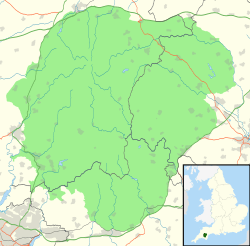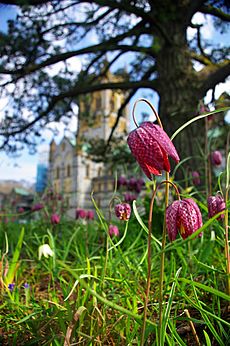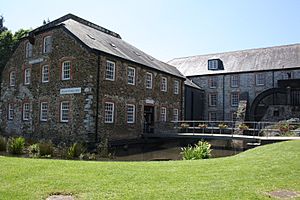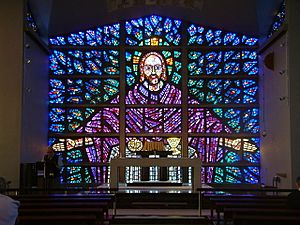Buckfast Abbey facts for kids
Quick facts for kids Buckfast Abbey |
|
|---|---|
| Abbey Church of St Mary | |
 |
|
| 50°29′34″N 3°46′32″W / 50.49278°N 3.77556°W | |
| OS grid reference | SX741673 |
| Location | Buckfastleigh, Devon |
| Country | UK |
| Denomination | Roman Catholic |
| Website | www.buckfast.org.uk |
| History | |
| Status | Benedictine Monastery |
| Founded | 28 October 1882 |
| Dedication | St Mary |
| Consecrated | 25 August 1932 |
| Architecture | |
| Functional status | Active |
| Heritage designation | Grade II |
| Designated | 10 January 1951 |
| Architect(s) | Frederick Walters |
| Completed | 1937 |
| Administration | |
| Parish | Buckfast |
| Deanery | Torbay |
| Diocese | Plymouth |
| Province | Southwark |
Buckfast Abbey is a working Benedictine monastery in Buckfast, near Buckfastleigh, Devon, England. This special place first became home to an abbey way back in 1018.
The first Benedictine abbey was followed by a different kind of abbey, built in 1134. This one was for Cistercian monks. In 1539, the monastery was closed down during the Dissolution of the Monasteries. Its buildings were taken apart and left in ruins. Later, the land was even used as a stone quarry, and then a large house was built there.
But in 1882, a group of French Benedictine monks bought the site. They started a new monastery dedicated to Saint Mary. New buildings and a temporary church were built, using parts of the old house. Buckfast officially became an Abbey again in 1902. Work on a brand new abbey church began in 1907. This church was built mostly on the same spot as the old Cistercian abbey. It was finished in 1938. Today, Buckfast Abbey is still an active Benedictine monastery and a registered charity.
Contents
The Abbey's Long History
Early Beginnings (1018-1147)
The very first abbey at Buckfast was started by Benedictine monks in 1018. People think it was founded by either Aethelweard, a local leader, or King Cnut. This first monastery was quite small and didn't have much money. We don't even know exactly where it was located. Its future was uncertain, especially after the Norman Conquest.
Around 1134, the abbey moved to its current location. King Stephen gave the land to a French abbot. This second abbey was home to Savignac monks. In 1147, the Savignac group joined the Cistercian order, so Buckfast became a Cistercian monastery. After this change, the abbey was rebuilt using stone.
Wealth and Decline in Medieval Times
During the Middle Ages, Buckfast Abbey became very rich. The monks made money from fishing and selling sheep wool. By the 14th century, it was one of the wealthiest abbeys in southwest England. It owned large sheep farms on Dartmoor, many estates, houses in Exeter, and fishing spots on the River Dart and River Avon.
The Black Death was a terrible sickness that hit in the mid-1300s. It killed two abbots and many monks. This meant there weren't enough monks to look after the buildings, and some fell apart. However, by the mid-1400s, the abbey was doing well again.
By the 16th century, the abbey started to decline. Not many new monks joined. When the abbey was closed in 1539, there were only 10 monks living there.
The Abbey Closes Down (1539)
In 1539, during the time of the Dissolution of the Monasteries, the last Abbot, Gabriel Donne, handed over the abbey to King Henry VIII's agent. He and the other nine monks received money every year from the King.
After the abbey closed, a lot of gold, silver, and other treasures from the abbey were sent to the Tower of London. The King then gave the land to others, including Sir Thomas Denys.
What Happened After the Closure?
After the abbey was closed, Sir Thomas Denys took apart the buildings, leaving them as ruins. The abbey site was then used as a quarry to get stone.
In 1800, a local mill owner named Samuel Berry bought the land. He had the ruins completely removed. In their place, he built a large house in a Gothic style and a wool mill in 1806. The Gothic house was built where the abbey's old cloister used to be. The only parts of the old abbey that were saved were some outer farm buildings and the tower from the abbot's old home. This tower is still there today.
Over the next 80 years, the Buckfast site was sold four times. In 1872, Dr. James Gale bought it. Ten years later, he wanted to sell it, but he hoped a religious group would buy it. An advertisement was placed, saying the Abbey would be "a grand acquisition could it be restored to its original purpose." Just six weeks after the sale, monks were living at the abbey again!
Rebuilding the Abbey
In 1882, French Benedictine monks bought the entire site. They had been forced to leave their monastery in France. On October 28, 1882, six Benedictine monks arrived at Buckfast.
Most of Samuel Berry's house was changed and became part of the new monastery buildings, which were built in 1882. A temporary church was built nearby. The current abbey church was built between 1906 and 1938. It mostly stands on the same spot as the old Cistercian Abbey.
The new abbey church was designed by architect Frederick Walters. It was built in a mix of old styles. Only a few monks worked on the building at any one time, but the whole community helped repair the old foundations. The building methods were simple, with wooden scaffolding held by ropes. Monks didn't wear safety gear, but luckily, no one was seriously hurt in any falls. Building continued even during World War I. Some German monks were allowed to stay at the Abbey as long as they didn't leave the grounds.
Buckfast officially became an Abbey again in 1902. Boniface Natter became the new abbot in 1903. He sadly died in a shipwreck in 1906. His friend Anscar Vonier became the next abbot and promised to finish rebuilding the abbey, as Boniface Natter had wished.
The abbey church was officially opened on August 25, 1932. However, the building wasn't completely finished for several more years. The last stone was laid in late 1937, and the final work was done the next year.
The only part of the medieval monastery that still stands is the old abbot's tower. It's been repaired a lot and dates back to the 14th or 15th century. This tower is now part of the abbey's guesthouse, which was built between 1982 and 1994.
Finishing Touches
In 1968, a monk named Dom Charles finished the huge east window in the Blessed Sacrament Chapel. He used a special technique called dalle de verre. This involves chipping colored glass into shapes and setting them like a mosaic in resin.
Today, many visitors come to Buckfast Abbey. There are guesthouses for people to stay in, and tours are offered. The hair shirt of Saint Thomas More is kept at a side altar in the Abbey. In 2017, new pipe organs were installed in the Abbey church.
The Abbey Grounds
The Abbey has a conference center and a restaurant called The Grange. On the west side of the Abbey, there are two gardens. These gardens have all sorts of plants, from herbs used in cooking or medicine to poisonous plants. There's also a private garden just for the monks. A bridge crosses the river to the abbey farm.
How the Abbey Supports Itself
The Abbey is self-supporting, meaning it earns its own money. It has a farm where vegetables are grown, and bees, pigs, and cattle are kept. There's a shop that sells wine, honey, beeswax, fudge, and other items made by religious communities. You can also find a gift shop, a book shop, and a restaurant.
Buckfast Bees
A monk named Brother Adam (born Karl Kehrle in Germany) was put in charge of the Abbey's beekeeping in 1919. He started a big project to breed a special kind of honeybee, now known as the Buckfast bee.
Brother Adam had to rebuild the bee colonies because a disease had wiped out most of the monastery's bees. The only bees that survived were from Italy. Brother Adam worked to create a new type of bee that was strong and resistant to diseases. The government even asked him to help restock bees across the British Isles with his special Buckfast bees. Today, the breeding of these bees is managed by a group in over 26 countries.
Schools Connected to the Abbey
Buckfast Abbey Preparatory School
From 1967 to 1994, the Abbey ran a prep school for boys aged 7 to 13. It had to close because fewer boys were boarding there, and it became too expensive to run.
St Boniface's Catholic College
During World War II, a school from Plymouth called St Boniface's Catholic College moved its students to Buckfast Abbey. They stayed there between 1941 and 1945. Later, the school named one of its houses "Abbey" to remember this time.
The Abbey Bells
The Abbey tower holds fifteen bells! There is a set of twelve bells that can be rung in a special way called "change ringing." These bells surround a huge 7.5-ton bell named Hosanna. Many people believe these are some of the best change ringing bells in the world. In August 2018, the Abbey held a special bell ringing festival to celebrate its 1000th year.
The bells were made in 1935 by John Taylor and Co. A local person donated them to the Abbey. They can also be played using an Ellacombe chiming machine, but it's not currently in use.
Important Abbots of Buckfast
An abbot is the head of a monastery. Buckfast Abbey has had many abbots throughout its long history.
Early Benedictine Abbots
- Alwin (Aelwinus): The first abbot mentioned around 1040.
- Eustace: Abbot when Buckfast joined the Cistercian order in 1143.
Cistercian Abbots
Even as Cistercians, the monks still followed the Rule of St. Benedict.
- William: Acted as a special representative for the Pope in 1190.
- Gabriel Donne (died 1558): The last abbot before the Abbey was closed by King Henry VIII in 1539.
Modern Benedictine Abbots (Since 1882)
Monastic life returned to Buckfast in 1882, and it became an abbey again in 1902.
- Right Rev Dom Boniface Natter: The first abbot of the new abbey, elected in 1902. He died in a shipwreck in 1906.
- Right Rev Dom Anscar Vonier: Elected in 1906, he promised to finish rebuilding the abbey. He died in 1938.
- Right Rev Dom David Charlesworth: Elected abbot in 1992 and again in 2009 and 2021.
Images for kids
See also
 In Spanish: Abadía de Buckfast para niños
In Spanish: Abadía de Buckfast para niños















